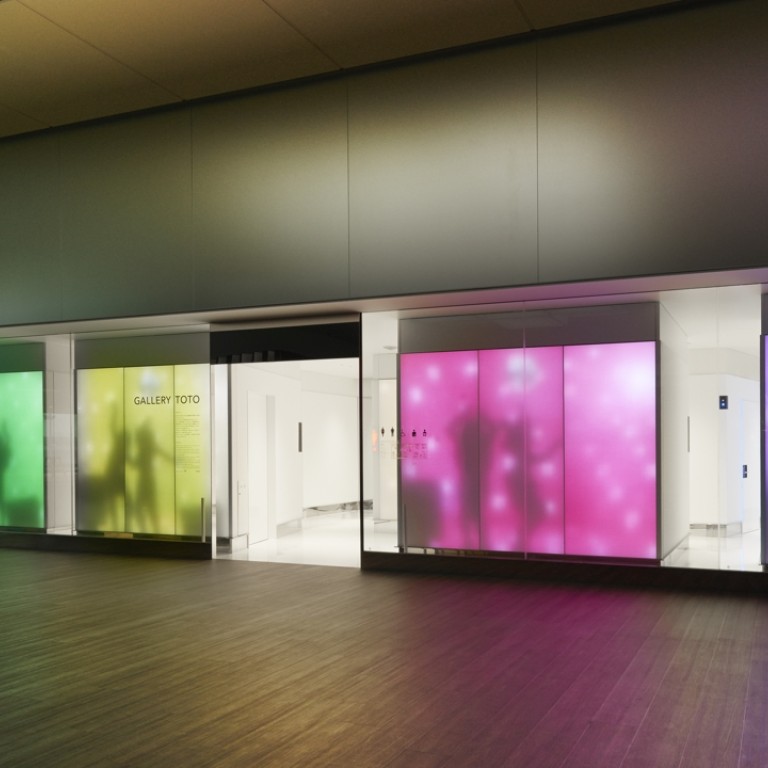
Japan’s Toto marks 100 years with ‘gallery’ to showcase merits of Washlet shower toilet
Japan’s leading bidet manufacturer and a Tokyo architectural design firm have created a ‘whimsical showroom’ at Narita airport targeting international travellers ahead of the 2020 Tokyo Olympics
It is unusual to find all your dinner party guests in the bathroom at the same time but when Kyoko Maeda mentioned she had installed a Toto Washlet shower toilet in her Hong Kong apartment, her guests – a mix of expatriates and local Chinese – crowded in to admire its heated seat, warm-water bidet function and deodorising technology.
The “all-singing, all-dancing” toilet may be revolutionary in Hong Kong but it is a common sight in Japan where 77 per cent of homes have one or more.
The price tag is often cited as a reason why the rest of the world has taken longer to succumb to its obvious charms but some cultures are also less willing to discuss bathroom preferences, making it harder to sell the merits of oscillating movements, massage or gentle drying technologies. Many people are also put off by the landing strip of buttons or the way some toilet models’ seats automatically rise as you approach.
That may all be about to change as Toto, Japan’s leading manufacturer, has embarked on a venture designed to win the hearts and minds (and other bodily parts) of travellers through a whimsical “gallery” that doubles as a showroom at Narita airport.
The project is a collaboration between the Narita Airport Authority, which is upgrading the airport’s facilities in preparation for the 2020 Olympics, and Toto, which celebrates its 100th anniversary in 2017.
The Tokyo-based designers, Klein Dytham Architecture, conceived the gallery as a clear glass box with four toilets each for men and woman, a toilet for disabled access and a nursing room.
“We were intrigued by the notion of the most private place simultaneously being in a very public place. We wanted to get away from the perception of toilets as closed and dark environments, where one rarely can see beyond the entrance area, and where one is usually confronted with a series of terraced stalls,” explains KDA co-founder Mark Dytham.
The gallery features a fabric-like screen facade comprising low-resolution LED panels that transform each toilet exterior wall facing the public lounge space into a digital screen (resembling a television screen with movement). Working with Black Bass creative agency and Japanese contemporary dance company Strange Kinoko, the designers choreographed several 20-minute performances of silhouetted happenings from dance parties to cleaning sequences at a life-sized scale – with water droplets to coloured waves – that appear as though the sequences are happening within the toilet spaces.
We wanted to spark one’s imagination, something unexpected and instantly memorable
“When not illuminated the wall looks just like a textile and is very soft, like a shoji screen,” says Dytham.
Inside, the toilet walls showcase Hydrocera ceramic sheets printed with large-scale landscape images of iconic Japanese landscapes.
“We wanted to spark one’s imagination, something unexpected and instantly memorable; a key moment that people could take home with them – or share on social media when they are at the airport,” explains KDA co-founder Astrid Klein.
“We asked ourselves, ‘What if the toilet walls were like semi-transparent shoji screens? What if one could see a shadow of what was going on inside the toilet room – something magical, beyond your wildest dreams... What if the interiors provided travel inspiration with gigantic images of Mount Fuji or beyond?’”
The venture has proved popular with travellers and was recently named as “best toilet” in Japan by the ministry of land, infrastructure and transportation.
Toto has reportedly sold 40 million of its Washlets worldwide since 1980 and while it is too early to measure whether its gallery has translated into travellers investing in new toilets once they return home, anecdotal evidence suggests the word is spreading.
In Hong Kong, Max Lee Hoi Leung of Cosy Home Consulting says he has noticed a significant increase in number of requests to install Japanese toilets. Most of his clients invest in the upgrade after having enjoyed first hand experience and prefer the Japanese model to cheaper imports from Malaysia and China.
“Most people fall in love with the experience after travelling to Japan or when they have lived there for some time and then relocate to Hong Kong,” he says. “It is more expensive than a regular toilet, (around HK$17,000 inclusive to install, including labour and materials) but it is much more hygienic, environmentally friendly and you use far less toilet paper.”
One client was so enamoured of his Washlet that he flew Lee to Germany to install four at his home in Heidelberg.
“Once you’ve had a Washlet it is very difficult to go back to the old style,” Lee says.

